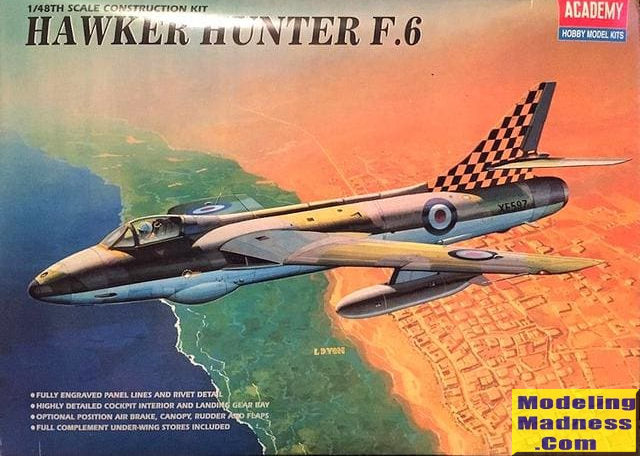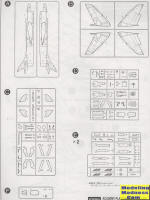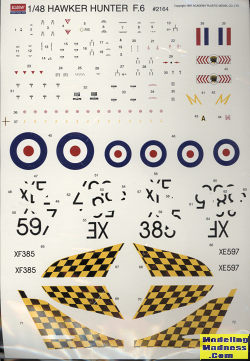
| KIT #: | 2164 |
| PRICE: | As little as $23.00 delivered 'used'. |
| DECALS: | Two options |
| REVIEWER: | Scott Van Aken |
| NOTES: | 1997 release |

| HISTORY |
The single-seat Hunter was introduced to service in 1954 as a manoeuvrable day interceptor aircraft, quickly succeeding first-generation jet fighters in RAF service such as the Gloster Meteor and the de Havilland Venom. The all-weather/night fighter role was filled by the Gloster Javelin. Successively improved variants of the type were produced, adopting increasingly more capable engine models and expanding its fuel capacity amongst other modifications being implemented. Hunters were also used by two RAF display teams: the "Black Arrows", who on one occasion looped a record-breaking 22 Hunters in formation, and later the "Blue Diamonds", who flew 16 aircraft. The Hunter was also widely exported, serving with a total of 21 overseas air forces.
During the 1960s, following the introduction of the supersonic English Electric Lightning in the interceptor role, the Hunter transitioned to being operated as a fighter-bomber and for aerial reconnaissance missions, using dedicated variants for these purposes. Two-seat variants remained in use for training and secondary roles with the RAF and the Royal Navy until the early 1990s. Sixty years after its original introduction it was still in active service, being operated by the Lebanese Air Force until 2014.
The Hunter saw combat service in a range of conflicts with several operators, including the Suez Crisis, the Aden Emergency, the Sino-Indian War, the Indo-Pakistani War of 1965, the Indo-Pakistani War of 1971, the Rhodesian Bush War, the Second Congo War, the Six-Day War, the War of Attrition, the Yom Kippur War, and the 2007 Lebanon conflict. Overall, 1,972 Hunters were manufactured by Hawker Aircraft and its successor, Hawker Siddeley, as well as being produced under licence overseas. In British service, the Hunter was replaced in its principal roles by the Lightning, the Hawker Siddeley Harrier and the McDonnell Douglas F-4 Phantom II.
The Hunter F.6 was Powered by one 10,150 lbf (45.17 kN) Rolls-Royce Avon 203 turbojet engine, revised wing with a leading edge "dogtooth" and four hardpoints, and a follow-up tailplane on later aircraft (also retrofitted to the early production examples) to improve pitch response at high Mach number, first flight 22 January 1954, 384 built. The Mk.6A was a modified F.6 with brake parachute and 230 gallon inboard drop tanks, for use at RAF Brawdy, where diversion airfields were distant.
| THE KIT |
 With the recent release (in Europe) of the Airfix 1/48 kit of this airplane,
I thought it might be useful to look at what it is, in the minds of some,
replacing. For sure, a 22 year old kit is not going to be at the same standards
as one recently tooled, but those of us who already have the Academy kit may not
be willing to rush out and grab the latest and greatest.
With the recent release (in Europe) of the Airfix 1/48 kit of this airplane,
I thought it might be useful to look at what it is, in the minds of some,
replacing. For sure, a 22 year old kit is not going to be at the same standards
as one recently tooled, but those of us who already have the Academy kit may not
be willing to rush out and grab the latest and greatest.
Let me start this by saying that the Academy kit has an issue that is often a deal breaker for some. The cockpit is not the right size. The seat is woefully underscale and the cockpit tub is far too shallow as a result. There are a few fixes for this. The cheapest is to get an aftermarket Martin Baker seat and sand the heck out of it to get it to fit into the smaller tub. You can also build this as a stand model and paint the inside of the canopy. Finally, you can get a resin cockpit correction set for it. True Details makes a set for this kit (TD49007) and it can be found for $15.00 delivered. Or you can live with it, for unless you take it where others will see it, no one will know and even then, they may not be knowledgeable enough to spot it. Another situation is that Academy molded the landing gear legs in the extended position. This is fairly easy to correct with a bit of cutting but for those who don't want to do that, Scale Aircraft Conversions offers a correction set (48173).
The rest of the kit is very much like the illustrations I've seen of the
Airfix kit. Separate canopy and windscreen, long intake trunking to an engine
compressor face, and long exhaust from the last stage. The flaps can be
displayed in the lowered position as can the speed brake. Rudder and ailerons
are separate. The kit has a separate tail sec tion to allow the FGA.9 tail with
the parabrake housing to be installed in that boxing.
tion to allow the FGA.9 tail with
the parabrake housing to be installed in that boxing.
Landing gear and doors look to be fairly correct, but I'm not a Hunter maven so cannot comment further on that. For things under wings you have four pylons with the option of fuel tanks for the inner ones along with various bombs and rocket pods for both pylons. You can also leave off the outer pylons and open holes in the lower wing for rockets.
Instructions are well done with generic color information. Markings are for two planes. One is the same as the Airfix kit with the yellow and black checkers from 63 squadron as shown on the box art. The other is a bit more subdued from 65 squadron. The decals are nicely printed and come with stencils.
| CONCLUSIONS |
Fans of the type will flock towards the new Airfix kit which will flood the market with second hand Academy kits for those who know a good deal and have access to a good replacement cockpit. As a further note, the most recent Academy release has parts included for the FGA.9.
February 2019
Copyright ModelingMadness.com. All rights reserved. If you would like your product reviewed fairly and fairly quickly, please
contact the editor
or see other details in the
Note to
Contributors. Back to the Main Page
Back to the Review
Index Page
Back to the Previews Index Page